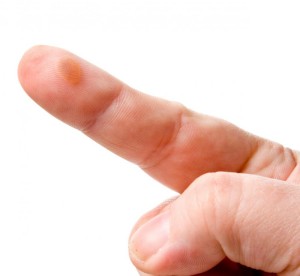A blister occurs when the outer skin layer detaches from the inner skin layer creating a bubble-like appearance of the affected area. The separation occurs due to friction, often caused by shoes or clothes. The space between the two layers of the skin fills up with tissue fluid which should not be punctured unless you are experiencing too much pain or if it is in a awkward location.
It is advisable to keep a blister intact as it acts a natural barrier against infection causing agents such as bacteria. You can cover a minor blister with an adhesive bandage and a larger one with plastic-coated, porous gauze so the affected region of the skin can breathe once the liquid is absorbed through the gauze.

Do not puncture a blister unless it is causing you too much pain and limiting your movements, such as blisters on the feet that may not allow you to walk properly. If you are diabetic, it is ideal that you consult your doctor and let him treat the blister.
Fever blisters
Fever blisters on the other hand, are caused by the herpes virus. Fever blisters occur around the mouth or inside it. Fever blisters are contagious and may result in prolonged, recurrent episodes. They frequently occur due to illness, sunlight, injury or stress.
Symptoms
- Bubble-like appearance of the affected area
- Redness
- Pain
- Itching and irritation
Treatment
If you are experiencing too much pain, you can drain the blister to alleviate the symptoms. Follow these steps to drain a blister:
- Rinse the blister and your hands with soap and warm water.
- Swab the affected region with rubbing-alcohol or iodine.
- Use a sterilized sharp needle (wipe it with alcohol) and puncture many points around the blister. Allow the blister to drain and do not try to peel off the overlying skin.
- Use a topical antiseptic cream to prevent infection and cover it with a bandage.
- Use sterilized scissors or tweezers to remove the dead skin after a few days.
- Visit your doctor if signs of infections such as drainage, pus, itchy sores, redness appear.
Prevention
- Use protective covering such as gloves, bandages or socks on areas that are prone to undergo a lot of friction.
- For athletes, special, padded socks can be used.
- Keep your feet dry at all times.
- Use moleskin in your shoes to prevent foot blisters.
- Wear shoes that match your foot size. Keep toe nails short and do not wear tight closed shoes.
- For fever blisters, avoid contact with infected casualties, try to lessen tension in your life and do not touch the blisters.
Learn More
To learn more about blisters and other skin injuries (and abrasions) take a St Mark James training program. Classes can be found on our training locations page from the main menu. Available courses can be in Halifax, Edmonton, Calgary, Ottawa, Vancouver, Toronto, Red Deer and Winnipeg.
Related Video on Blisters
http://www.youtube.com/watch?v=086cqlwjUic
